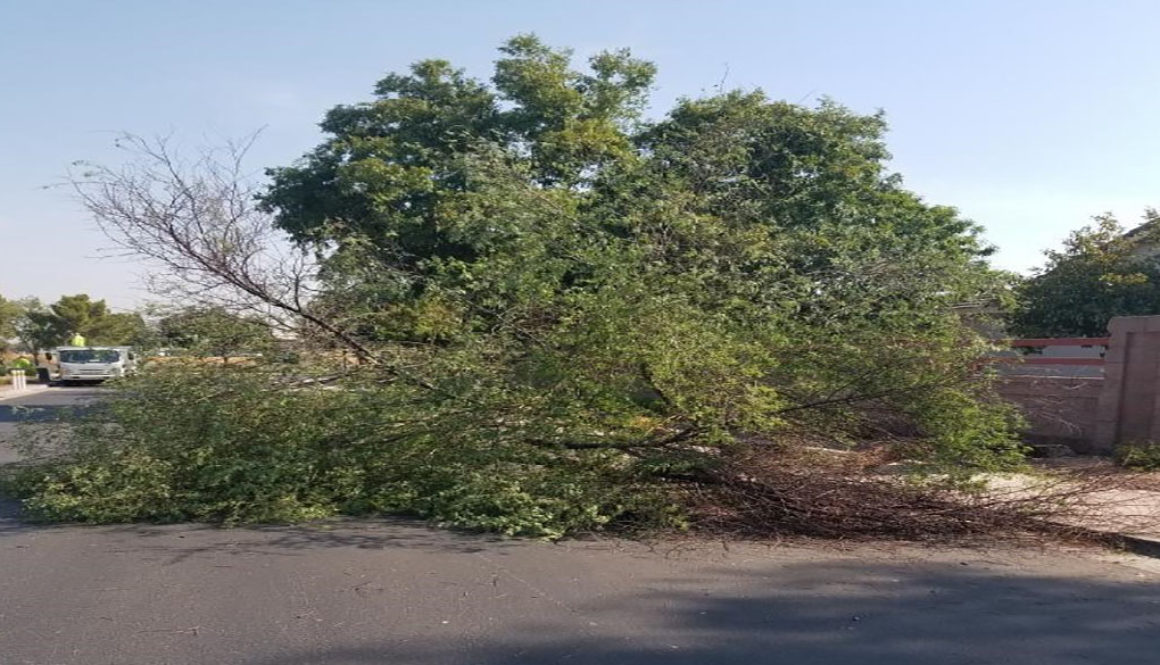Restorative Pruning For Storm Damaged Trees
Has Monsoon Season taken a toll on your community, or residential, trees? With high winds and furious downpours of rain, our trees can take a beating during our seasonal storms!
The first step in addressing storm damage to a tree is evaluating whether the tree can be saved or, rather, the tree would be a hazard if left. Some factors in this decision are: the extent of the damage to the crown of the tree, the survivability of the tree, the direction of the crown after the damaged portion is removed, and the surrounding tree coverage in the growing area.
If the extent of the damage to the crown of the tree is severe, or the tree has multiple years of continuous damage repair, the tree might be a good candidate for removal. Continuing to restore the canopy year after year may lead to unnecessary elevation of the crown and leave the tree with branch attachments that are potentially weak and prone to breaking. This continued repair might also leave the tree in a state of recovery mode as it accelerates its growth response to combat infections, diseases, or pests. The tree can develop an abnormal amount of advantageous growth that is both weakly attached and aggressive in its nature to demand nutrient resources from the parent tree.
The survivability of the tree is important and should be taken in to consideration as it relates to the amount of damage a tree sustains. Some species of trees are better at recovering from split branches, trunk stress, and limb damage than others. Another consideration is what part of the tree was damaged. Trees, and branches, have apical growth points to them. This is the area that causes branches to become longer and trees to become taller. Typically, this area is located at the upper-center portion of the tree. With our desert trees being decurrent in growth, they may have multiple apical growth points which it easier to restructure a new crown that has extensive damage. A pine tree, should it lose the upper portion of the crown, might not be a good candidate for restorative pruning as once a pine tree loses its main (or apical) stem growth point a new one cannot be grown.

Another item to evaluate would be the direction of the crown of a tree once the damage is removed. At times, it’s necessary to remove damaged limbs that have fallen on a wall, or roadway, leaving the tree unbalanced and in a direction that is undesirable. This unbalanced tree structure, and as the tree puts new recovery growth on, can put additional stress on a portion of a tree that might’ve been accustomed to sharing the canopy weight over its entire structure system. Once that system is re-directed, the internal road map of the tree might become overloaded and cause a decline in the tree.
An additional factor in whether or not to select a tree for restorative repair is the surrounding trees. If the surrounding trees are great in number, healthy, and are only minimally damaged then the severely damaged tree might be selected for removal. Depending on the landscape in the area, a tree might instead be selected to be repaired on a temporary basis. A suggestion would be to plant a new tree nearby as the heavily damaged tree is removed in phases. This will give the new tree time to root in and grow as the older tree is removed.
After the evaluation has been completed, and the damaged trees are selected, develop a plan for the pruning of the damaged limbs. Limbs should be cut beyond the split, outside of the branch collar, or at the lateral branch along a desirable stem. Using the reduction pruning method on damaged branches can help re-direct growth so a new canopy can be developed. This method can also be used to reduce the branch length left after the damage has been removed to better balance the tree. Keep in mind, the extensive nature of some tree damage might take several seasons to repair. Using temporary branches (branches that are kept only for a season with the intention of removing them as soon as the tree recovers) can help the tree recover and develop new growth at a much healthier rate.
If possible, keep the overall ordinary pruning, such as: elevation pruning, co-dominant stem removal, thinning, crown cleaning, and crowding branch removal to a minimum as the tree recovers. A severely damaged tree will need all of its resources to recover from the damage, all while limiting the potential for infection by pest or disease.
Our Arbor team at ELS is happy to help develop a site specific plan for your tree recovery needs, including developing long term recovery plans for your community tree forest!
Download a Shareable Version of This Document for Your Community!

